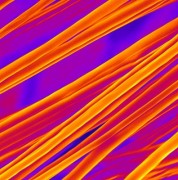A new method for the production of a new method for the production of tiny nanofibers, consisting of a combination of a high-speed centrifuge and a cotton candy machine, has been developed by bioengineers from Harvard University

Tiny nanofibers, consisting of a combination of a high-speed centrifuge and a cotton candy machine, were developed by bioengineers from Harvard University.
The reliance of the lead author of the paper describing the research, Mohammad Reza Badrossamay, on the delight of cotton candy found at fairs is intentional, since the current device also spins, stretches, and pulls out polymer-based fibers that are a hundred nanometers in diameter by spinning a tiny tubular nozzle.
The invention, which was reported in the scientific journal Nano Letters, could be a clear advantage for the industry since it has the ability to be used for the development of possible applications ranging from the production of artificial organs and the regeneration of tissues to clothing and air filters. The researchers applied for a patent for this invention.
"This is the more efficient method of preparing nanofibers, to a large extent, compared to existing methods, while obtaining a higher production yield by tens of meters," says one of the researchers. "Our method will be in great demand in the industry, since the simple machines will allow the production of nanofibers in the laboratory. In fact, with the help of this method, we will be able to greatly advance the field of nanofabric production."
Contrary to this, the most accepted method today for the production of nanofibers is with the help of electrospinning (the entry in Wikipedia), or by applying a high electric voltage inside a drop of polymeric liquid to obtain long strands of nanometer threads. Despite the effectiveness of the method, it provides limited control and low yield of the desired fibers.
The Harvard researchers turned to a simpler solution, using a rotating jet nozzle. Fast feeding of the polymeric material and its rotation in a tank located above a controllable motor, provide greater control and higher utilization.
As it spins rapidly, the polymeric material stretches, similar to what happens to molten sugar that begins to dry into tiny silk-like strips. Just like in the production of cotton candy, the nanofibers exit through a tiny tubular nozzle thanks to the combination of hydrostatic pressure and centrifugal force. The pile of fibers coming out of the nozzle form a kind of bagel structure with a diameter of ten centimeters.
"The new method enables the production of natural and artificial polymers as well as a high level of control compared to other accepted methods (fiber alignment, web porosity, hierarchical and spatial organization of fibrous scaffold and three-dimensional assemblies)," notes the researcher.
The researchers tested the new device by using a variety of natural and artificial polymers such as polyacetic acid in chloroform - a biodegradable polymer produced from corn or sugar cane starch and used as an environmentally friendly alternative to plastic products such as disposable cups.
Moreover, the fast spinning method provides a high level of flexibility since the diameter of the fibers can be easily changed and the resulting structures can be adapted to regular three-dimensional structures or any other simple shape by adjusting the way the fibers are collected.
Another research group, which has extensive experience in heart tissue engineering, also used the innovative method to prepare scaffolds for tissue engineering (artificial structures on the back of which tissues develop and grow). Cardiac tissue derived from mice was incorporated in a controlled manner with nanofibers, and as previously observed with other methods, a beating muscle was formed.
"These findings are the first step in the development of methods for creating miniaturized scaffolds in the living body," explains the researcher. "The findings prove that our method is highly versatile both for scientific research and for everyday use. Since it does not require the application of high voltage, it enables wide accessibility to the production of nanofibers for every researcher."
In the next step, the researchers intend to improve the applications for tissue engineering and look for opportunities to utilize the invention for fabric applications.
The news from the university

One response
Definitely an effective method for turning polymeric waste into fibers